Tracking your harvests is a great way to see how well your garden performs each year. In this post, I’ll show you how to keep track of your harvests step-by-step.
Plus, I’ll give you a free printable garden harvest tracking sheet that will make it super easy for you to record everything.
Keeping track of your harvests may seem tedious, but it ultimately helps you be a more successful gardener. First of all, it’s fun to see how much food you can grow in your garden.
But when you keep records like this, it will also be easier to plan for future years. You can see exactly what’s working the best in your garden, and ditch the stuff that isn’t.
You can also compare it to your previous records to see how your garden performs year over year.
Plus, you can find out how much money your garden saves you at the supermarket. And trust me, this can be a huge eye-opener, especially if you calculate the cost of buying organic produce.
Benefits Of Tracking Your Harvests
There are tons of benefits for keeping track of your harvests. I already touched on a few above, but I thought it would be best to list them all out for you in once place. So, here are the benefits of recording your garden harvests…
- Calculate how much total produce your garden grows each year
- See how much of each type of crop you harvested during the season
- Help you to plan for next year
- Find out your yield per square foot (if that’s your thang)
- See what did well, and what didn’t
- Determine what was worth the space and effort, and what wasn’t
- Figure out how much money you saved at the grocery store
- Reflect on your process by looking back at historical data (journaling)
- Compare how your garden performs year over year
- Enable you to get as much food as possible from your garden
- Earn bragging rights by showing your family and friends exactly how much food you grew
How To Track Your Harvests
It’s best to track your harvests by either weight (pounds or ounces), or by volume (ounces, cups, or gallons). Weight is the most accurate unit of measure. It’s easy to weight everything you harvest using an inexpensive kitchen scale.
I don’t recommend tracking by the amount of items you harvested. The reason is because each item you grow in your garden can be a different size, even if it comes from the same crop.
Regardless of whether you choose weight or volume, just be sure to be consistent. Stick to the same unit of measure for each type of crop throughout the season.

How To Use My Garden Harvest Tracking Sheet
To make it super easy for you to get started recording your harvests, I decided to share my custom-designed tracking sheet with you. I created this Garden Harvest Tracking Sheet several years ago in order to record my own harvests.
It’s very simple to use, and you don’t need to buy any fancy software. This handy printable tracking sheet can sit right on your counter so you can quickly pencil in your numbers with each new harvest.
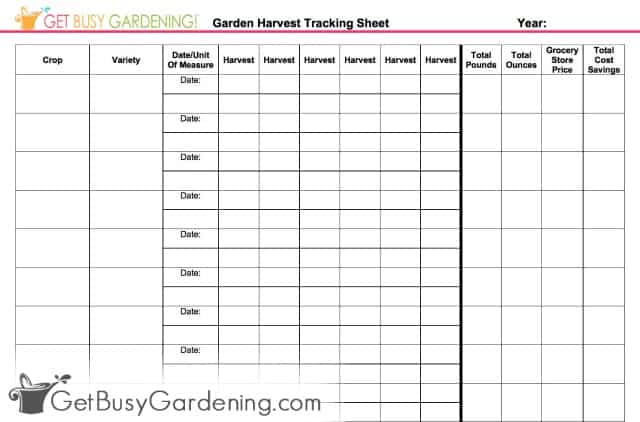
Supplies Needed
- Kitchen scale, a measuring cup, large measuring bowl, or gallon bucket
- Pen or pencil
- My Garden Harvest Tracking Sheet
Step-By-Step Instructions:
Step 1: Download and print the sheet – Here’s a link to download the sheet… Garden Harvest Tracking Sheet. The sheet has some color on it, but it’s mostly black & white. So, you can print it either in color or B&W.
Just be sure to set your printer to landscape, if it doesn’t default to that. After printing out the sheet, the first thing to do is write the year in the upper right hand corner.
Step 2: Determine the unit of measure for each crop – As I said above, weight is the most accurate. A good rule of thumb is to use the same unit of measure that your grocery store does.
For example, heavier vegetables (e.g.: cucumbers, beans, potatoes) are usually sold in pounds, and lighter weight crops (e.g.: salad greens, herbs) in ounces.
Related Post: How & When To Harvest Sage Fresh From Your Garden
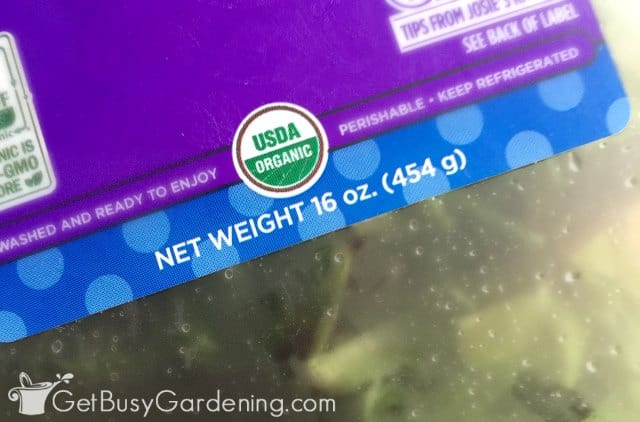
Step 3: Measure your harvest – Each time you harvest any item from your garden, bring it inside and measure it right away. Either use your kitchen scale to weigh it, or use a measuring cup, a large measuring bowl, or a one gallon bucket (for huge harvests!).
Step 4: Record it on the sheet – The first two lines on the harvest tracking sheet are examples of how to use it. Write down the crop and the variety (optional), then fill in the unit of measure you plan to use for that specific crop.
Next, put the date in the first column, and the amount you harvested (weigh/volume) right below it.
Note: if you’re weighing heavier vegetables, sometimes it works best to record both the pounds and ounces. Then, when you add everything, up you can convert all of those extra ounces into total pounds.
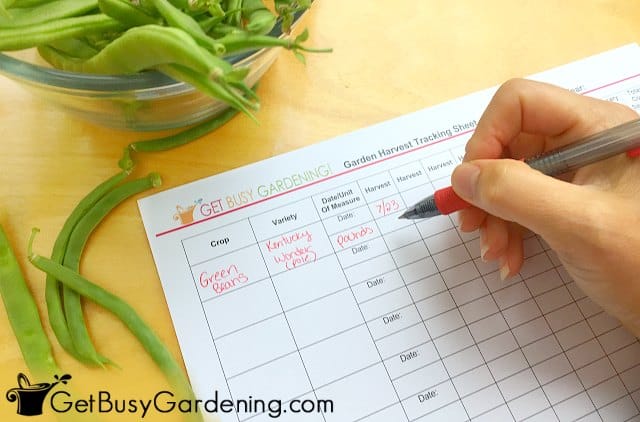
Step 5: Continue to record your harvests – As you harvest throughout the season, continue tracking every item, and recording it on the worksheet.
Each time you harvest something that’s already on the sheet, you just need to add in the date and amount on that same row.
Otherwise, start another row for each newly harvested crop. If you need additional rows and columns, simply print more copies of the sheet.
Step 6: Record the grocery store prices (optional) – If you want to take it one step further, bring your sheet to the grocery store in order to calculate the cost savings.
For each item on your sheet, write down their unit of measure, and the price you would pay for it.
If you grow your food organically, then be sure to use that price. For example, organic tomatoes at my local supermarket cost $2.69 per pound.
Record the supermarket prices as you go, or wait until your sheet is completely filled in, and do it all at once. Just keep in mind that if you wait too long, then seasonal summer vegetables may no longer be available at the store.
You should be able to get prices for many of the items on your sheet. However, sometimes they either won’t carry it in the organic section, or you can’t find it at all.
Don’t feel bad. That just gives you further validation that those crops are worth growing.
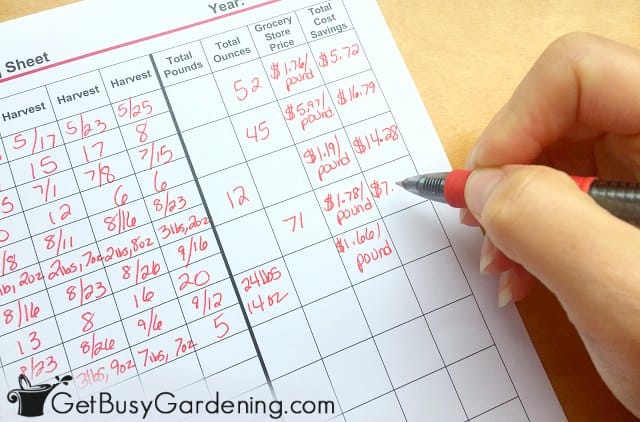
Step 7: Calculate your cost savings (optional) – Once you’re done harvesting, and have recorded all the prices you can, then it’s time to add up the totals.
Expanding on my earlier example… last year I harvested 30.5 pounds of organic tomatoes from my garden.
If I were to buy all of those at my local supermarket, I would have paid a total $82.05! WOW!
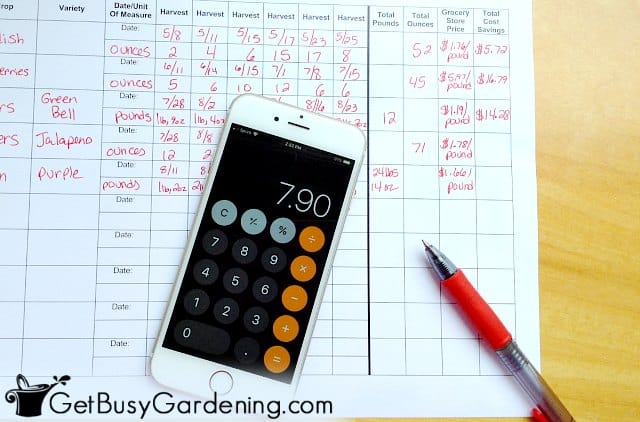
Step 8: Keep your sheet for next year – Tuck your harvest tracking sheets away somewhere to save them for next year.
You can use them for planning your next vegetable garden, and also to compare how much your harvests change each year.
Tracking your garden harvests is both rewarding and satisfying. It’s amazing how much even a small garden can save you on your grocery bill. Plus, it really helps you to see which crops are worth growing, and which ones you can feel good about skipping next year.
If you’d like to learn how to make the most of your space and get as much homegrown food as possible, then my Vertical Vegetables book is perfect! It will teach you all you need to know, has tons of gorgeous photos, and includes 23 DIY projects you can build for your own garden. Order your copy today!
Learn more about my Vertical Vegetables book here.
Share your tips or method of tracking your harvests in the comments section below.
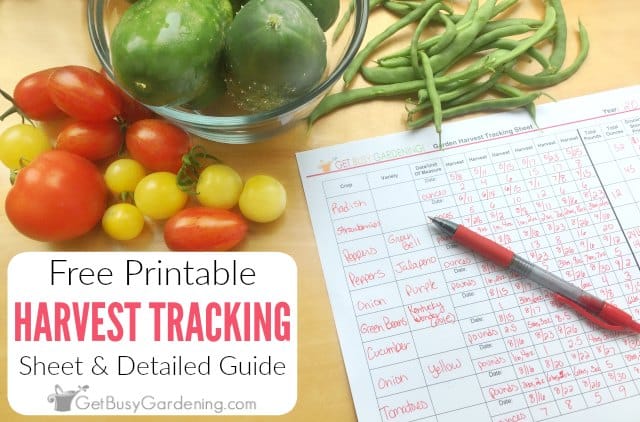




John Dzurenko says
I’ve been looking for a good harvest tracker, basically for tomatoes only and this one is nice. I would like to recommend you create a spreadsheet from it and use that. MUCH more usable, editable, storable, and wastes NO paper & ink.
Amy Andrychowicz says
You’re welcome! Maybe some day we’ll upgrade this harvest tracker to something more sophisticated, thanks for the suggestion.
Sarah says
Wow. I didn’t realize how much money a person can save by growing their own food. Not only does it save a considerable amount, it is much, much healthier as well! ? Thank you for sharing this. I love it.
Amy Andrychowicz says
You’re welcome! And yes, it’s so much healthier! I know where all this food came from, and I know it’s chemical free. <3
Stan Smith says
That’s quite fascinating!!!
After moving to Europe seven years ago I had to start over with everything and if I’d compared the prices then I’d have surely been disappointed, but now I spend an equivalent of a weeks worth of groceries that provides us with fruits and vegetables for months.
The second garden we added this year will pay off even sooner since I have learned where to buy bulk soil, compost (of course I make my own too … I just cannot keep up with my own demands) and mulch for pennies rather than dollars.
400 liters of mulch at the garden center is 50 € while I paid 30 € for 1500 liters at a place much closer to my garden once I’d learned of its existence.
Amy Andrychowicz says
Awesome, thanks for sharing your story!
Carole Coates says
In the past, I’ve kept track of how much food I preserve, but never thought about weighing it as it comes in from the garden. Doing that this year. The exercise angle can also be a cost saver (compare to gym membership), not to mention the money you might be saving by healthy eating, stress reduction, etc. Not so easy to measure, but the list could go on and on.
Amy Andrychowicz says
Yes, that is so true! Have fun tracking your harvests. I bet you’ll be pleasantly surprised by how much produce you can grow!
Sue says
It’s great to track all the fresh veggies and see how much money you save. Plus think of the exercise a person gets when gardening. Since I don’t like to do regular exercise, gardening works for me.
Amy Andrychowicz says
Yes, there are so many wonderful benefits to gardening!
Sugar says
Very interesting. I am glad you took the time to evaluate and share with us. I enjoy my garden for the quality of the veggies so much, I honestly never thought about tracking my harvests, or the money I was saving!
Amy Andrychowicz says
I’m glad you found my harvest tracking sheet so useful! It’s fun to see how much money you can save by growing your own veggies. 🙂